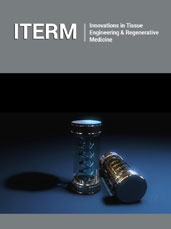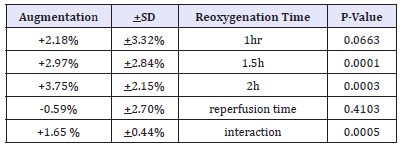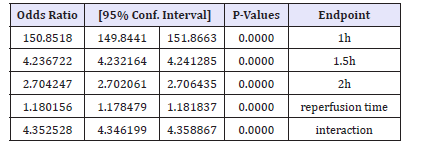- Submissions

Full Text
Innovation in Tissue Engineering & Regenerative Medicine
Comparison of the Acute Hypervolemic Capacities of Erythropoietin and U-74389G Concerning Mean Corpuscular Volume Levels
Τsompos C1*, Panoulis C2, Τοutouzas K3, Triantafyllou A4, Ζografos CG3, Kalliopi T5, Maria Karamperi5 and Papalois A5
1 Department of Gynecology, General Hospital of Thessaloniki “St. Dimitrios” Thessaloniki, Greece
2 Department of Obstetrics & Gynecology, Athens University, Greece
3 Department of Surgery, Athens University, Greece
4 Department of Biologic Chemistry, Athens University, Greece
5 Experimental Research Centre, ELPEN Pharmaceuticals, Greece
*Corresponding author:Tsompos Constantinos, Department of Gynecology, General Hospital of Thessaloniki “St. Dimitrios”, 2 Elenis Zografou street, Thessaloniki 54634, Hellas, Greece
Submission: July 30, 2018;Published: August 17, 2018

Volume1 Issue1 August 2018
Abstract
Aim: This study compared the hyper volemic capacities of erythropoietin (Epo) and antioxidant drug U-74389G based on 2 preliminary studies. The provided results at mean corpuscular volumes (MCV) levels augmentation were co-evaluated in a hypoxia re oxygenation protocol of an animal model.
Materials and methods: MCV levels (MCVl) were evaluated at the 60th reoxygenation min (for groups A, C and E) and at the 120th reoxygenation min (for groups B, D and F) in 60 rats. Groups A and B received no drugs, rats from groups C and D were administered with Epo; whereas rats from groups E and F were administered with U-74389G.
Results: The first preliminary study of Epo non-significantly increased the MCVl by 0.30%+0.39% (p-value=0.4430). However, the second preliminary study of U-74389G significantly rised the MCVl by 1.60%+0.43% (p-value=0.0005). These 2 studies were co-evaluated since they came from the same experimental setting. The outcome of the co-evaluation was that U-74389G has 4.352528-fold hypervolemic potency than Epo (p-value=0.0000).
Conclusion: The anti-oxidant capacities of U-74389G accelerate the acute hypervolemic properties; presenting 4.352528-fold rise on MCVl than epo (p-value=0.0000).
keywords: Bio acoustic deterrents; Sonic weapons; Carcinogenesis; Loss of hearing, Balance, Brain injuries, Nausea, Headaches, Ear ringing, State department, The US consulate in Guangzhou, China, Havana-case, Cuba, Secretary of state mike pompeo
Introduction
The acute hyper volemic capacity 1 of U-74389G is thus significant (p-value=0.0005). U-74389G is a novel antioxidant factor. It implicates just only 256 known biomedical studies at present. 4.29% of these studies concern tissue hypoxia and reoxygenation (HR) experiments. The promising effect of U-74389G in tissue protection has been noted in these HR studies. U-74389G or also known as 21-[4-(2,6-di-1-pyrrolidinyl-4-pyrimidinyl)- 1-piperazinyl]-pregna-1,4,9(11)-triene-3,20-dione maleate salt is an antioxidant which prevents both arachidonic acid-induced and iron-dependent lipid peroxidation. It protects against HR injury in animal heart, liver and kidney models. These membraneassociating antioxidants are particularly effective in preventing permeability changes in brain microvascular endothelial cells monolayers. Lazaroids, a novel series of glucocorticoid compounds 21-aminosteroids have the properties of free radical scavenging. U-74389G is one of the 132 similar lazaroid compounds. It has a molecular weight of 726.90406g/mol; it has a selective action on vascular endothelium with vitamin E-like properties.
However, the hypervolemic capacity of U-74389G gets more comprehensible whether is compared with the same capacity of a standard known drug. Such one of the most well studied drug; actually with original erythropoietic capacity (p-value=0.4430) is erythropoietin (Epo). Indeed, Epo implicates over 30,070 known biomedical studies at present. 10.55% at least of these studies concern tissue hypoxia and reoxygenation (HR) experiments. Certainly, the concept has been moved away from the original action of Epo in stem blood cells recovery. However, just few related reports were found, not covering completely the specific matter with antioxidant factors.
The special aim of this experimental work was to compare the acute hypervolemic capacities of U-74389G and Epo on a rat model and mainly in an HR protocol. Their effects were tested by measuring the mean corpuscular volumes (MCV) levels.
Materials and Methods
Animal preparation
The Vet licenses of the research were provided under 3693/12- 11- 2010 & 14/10-1-2012 decisions. The granting company and the place of experiment are mentioned in related references [1,2]. Appropriate humanistic care was adopted for Albino female Wistar rats. 7 days pre-experimental normal housing included ad libitum diet in laboratory. Continuous intra-experimental general anesthesia, oxygen supply, electrocardiogram, acidometry and postexperimental euthanasia were provided. Rats 16-18 weeks old were randomly delivered to six (6) groups (n=10), using the following protocols of HR: Hypoxia for 45 min followed by reoxygenation for 60min (group A); hypoxia for 45 min followed by reoxygenation for 120min (group B); hypoxia for 45min followed by immediate Epo intravenous (IV) administration and reoxygenation for 60min (group C); hypoxia for 45min followed by immediate Epo IV administration and reoxygenation for 120min (group D); hypoxia for 45min followed by immediate U-74389G intravenous (IV) administration and reoxygenation for 60 min (group E); hypoxia for 45 min followed by immediate U-74389G IV administration and reoxygenation for 120 min (group F). The dose height selection criteria of Epo and U-74389G were assessed at preliminary studies as 10mg/Kg body mass of animals for both drugs.
Hypoxia was caused by laparotomic clamping inferior aorta over renal arteries with forceps for 45min. The clamp removal was restoring the inferior aorta patency and reoxygenation. After exclusion of the blood flow, the protocol of HR was applied, as described above for each experimental group. The drugs were administered at the time of reperfusion; through inferior vena cava catheter. The MCV levels (MCVl) were determined at 60th min of reoxygenation (for A, C and E groups) and at 120th min of reoxygenation (for B, D and F groups).The animals’ mass was a confusing factor for MCVl presenting a very powerful relation (p-value=0.0000).
Statistical analysis
(Table 1) presents the (%) augmentation influence of Epo regarding reoxygenation time. Also, (Table 2) presents the (%) augmentation influence of U-74389G regarding reoxygenation time. Chi-square tests were applied using the ratios which produced the (%) results per endpoint. The outcomes of chi-square tests are depicted at (Table 3). The statistical analysis was performed by Stata 6.0 software [Stata 6.0, StataCorp LP, Texas, USA].
Table 1:The (%) augmentation influence of erythropoietin in connection with reoxygenation time.

Table 2:The (%) augmentation influence of U-74389G in connection with reoxygenation time.

Table 3:The U-74389G/erythropoietin efficacies ratios on MCV levels augmentation after chi-square tests application.

Results
The successive application of chi-square tests revealed that U-74389G accentuated the hypervolemia by 150.8518-fold [149.8441-151.8663] than Epo at 1h, by 4.236722-fold [4.232164- 4.241285] at 1.5h, by 2.704247-fold [2.702061-2.706435] at 2h, by 1.180156-fold [1.178479-1.181837] without drugs and by 4.352528-fold [4.346199-4.358867] whether all variables have been considered (p-value=0.0000).
Discussion
The unique available study investigating the rising effect of U-74389G on MCVl was the preliminary one1. Although the most famous activities of neuro protection and membrane-stabilization properties, it accumulates in the cell membrane, protecting vascular endothelium from per oxidative damage but hardly penetrates the blood-brain barrier. It elicits a beneficial effect in ototoxicity and Duchenne muscular dystrophy. It increases γGT, SOD, and GSH levels in oxygen-exposed cells. It treats septic states and acts as immunosuppressant in flap survival. It prevents the learning im pairments, it delays the early synaptic transmission decay during hypoxia improving energetic state of neurons. It shows antiproliferative properties on brain cancer cells and is considered as a new promising anti inflammatory drug for the treatment of reperfusion syndrome in IR injuries.
The same authors confirmed2 the short-term hyper volemic effect of Epo preparations in non iron deficient individuals. Kaliev et al. [3]. evaluated increased MCV values in patients with chronic glomerulonephritis by using erythropoietin and its combination with hypoxic altitude chamber training. Sinkeler et al. [4] positively associated the mean corpuscular volume with gender-stratified tertiles of age-corrected EPO4--a marker for inflammation, angiogenesis and hypoxia-also associated with cardiovascular disease in renal transplant recipients. Richmond et al. [5] determined serum EPO concentrations and mean corpuscular volume (MCV) values varied with age in free-ranging Steller sea lions (Eumetopias jubatus). Tsantes et al. [6]. Confirmed the assumption that waves of release of relatively immature, large red cells from the marrow, including an increased number of F-cells, reflect the recruitment of normally dormant BFU-E (bursts forming units of erythrocyte precursors); since they observed macrocytosis (increased MCV)6 in almost half patients of hypoxemic chronic obstructive pulmonary disease (COPD); while erythrocytosis was developed to a lesser degree (37.5%). The F-cell percentage was significantly elevated in the COPD group (P< 0.01) and was associated with MCV values (P< 0.05). Vogel et al. [7] showed doubled reticulocyte counts, an increased mean corpuscular volume and a moderate increase in viscosity; explicable by the up to 3-fold higher elongation of erythrocytes at physiologic shear rates in transgenic mice. Ebara et al. [8] noticed abnormally enlarged erythrocytes and hemoglobin concentration in peripheral blood increased proportional with the increase of mean corpuscular volume in vitamin B12-deficient rats in hypoxia.
Haddad et al. [9] examined the effect of intraperitoneal injections of 40mg/kg of the lazaroid compound U-74389G every 12 hours, on acute otitis media in guinea pigs. Streptococcus pneumoniae organisms were inoculated into the right tympanic cavity; with the left ear served as a control one. According to above, Table 3 shows that U-74389G accentuated by 4.352528-fold [4.346199-4.358867] the hypervolemic potency on MCVl than Epo (p-value=0.0000); a trend accentuated along time, in Epo non-deficient rats. A metaanalysis of these ratios from the same experiment, for 12 other seric variables, provides comparable results (Table 4).
Table 4:A U-74389G/erythropoietin efficacies ratios meta-analysis on 15 hematologic variables (13 variables with balancing efficacies and 2 variables with opposite efficacies) [10-12].

Conclusion
The anti-oxidant capacities of U-74389G accentuated by 4.352528-fold [4.346199-4.358867]the hypervolemic potency than Epo (p-value=0.0000) in rats [10]. However, this trend is attenuated along the short-term time frame of the experiment [11,12].
References
- Τsompos C, Panoulis C, Τοutouzas K, Triantafyllou A, Ζografos G, et al. (2015) The acute effect of the antioxidant drug “U-74389G” on mean corpuscular volume levels during ischemia reperfusion injury in rats. Research Journal of Pharmacology and Toxicology 01(5): 54-57.
- Τsompos C, Panoulis C, Τοutouzas K, Triantafyllou A, Ζografos G, et al. (2016) The acute effect of erythropoietin on mean corpuscular volume levels during hypoxia-reoxygenation injury in rats. Journal of Cellular Biotechnology 2(1): 77-83.
- Kaliev R, Murkamilov IT, Fomin VV, Kaliev KP, Averianova NI (2014) Effect of erythropoietin and its combination with hypoxic altitude chamber training on the clinical and functional manifestations of chronic glomerulonephritis. Ter Arkh 86(10): 40-46.
- Sinkeler SJ, Zelle DM, Homan Heide JJ, Gans RO, Navis G, et al. (2012) Endogenous plasma erythropoietin, cardiovascular mortality and allcause mortality in renal transplant recipients. Am J Transplant 12(2): 485-491.
- Richmond JP, Burns JM, Rea LD, Mashburn KL (2005) Postnatal ontogeny of erythropoietin and hematology in free-ranging steller sea lions (Eumetopias jubatus). Gen Comp Endocrinol 141(3): 240-247.
- Tsantes AE, Papadhimitriou SI, Tassiopoulos ST, Bonovas S, Paterakis G, et al. (2004) Red cell macrocytosis in hypoxemic patients with chronic obstructive pulmonary disease. Respir Med 98(11): 1117-11123.
- Vogel J, Kiessling I, Heinicke K, Stallmach T, Ossent P, et al. (2003) Transgenic mice overexpressing erythropoietin adapt to excessive erythrocytosis by regulating blood viscosity. Blood 102(6): 2278-2284.
- Ebara S, Adachi S, Takenaka S, Enomoto T, Watanabe F, et al. (2003) Hypoxia-induced megaloblastosis in vitamin B12-deficient rats. Br J Nutr 89(4): 441-444.
- Haddad J, Egusa K, Takoudes TG (1998) Effects of 21-aminosteroid U-74389G on acute otitis media in a guinea pig model. Otolaryngol Head Neck Surg 118(1): 44-48.
- Τsompos C, Panoulis C, Τοutouzas K, Triantafyllou A, Ζografos CG, et al. (2018) Comparison of the hypoglucemic effects of erythropoietin and U-74389G on glucose levels. Archives of Hematology and Blood Diseases 1(1): 5-12.
- Tsompos C, Panoulis C, Toutouzas K, Triantafyllou A, Zografos GC, et al. (2018) Comparison of the acute erythropoietic capacities of erythropoietin and U-74389G concerning mean corpuscular hemoglobin levels. Sumerianz Journal of Biotechnology 1(1): 7-11.
- Tsompos C, Panoulis C, Toutouzas K, Triantafyllou A, Zografos GC, et al. (2018) Comparison of the hypazotemic effects of erythropoietin and U-74389G on urea levels. Clinic Res Urol 1(1): 1-6.
© 2018 Τsompos C. This is an open access article distributed under the terms of the Creative Commons Attribution License , which permits unrestricted use, distribution, and build upon your work non-commercially.
 a Creative Commons Attribution 4.0 International License. Based on a work at www.crimsonpublishers.com.
Best viewed in
a Creative Commons Attribution 4.0 International License. Based on a work at www.crimsonpublishers.com.
Best viewed in 







.jpg)






























 Editorial Board Registrations
Editorial Board Registrations Submit your Article
Submit your Article Refer a Friend
Refer a Friend Advertise With Us
Advertise With Us
.jpg)






.jpg)














.bmp)
.jpg)
.png)
.jpg)










.jpg)






.png)

.png)



.png)






